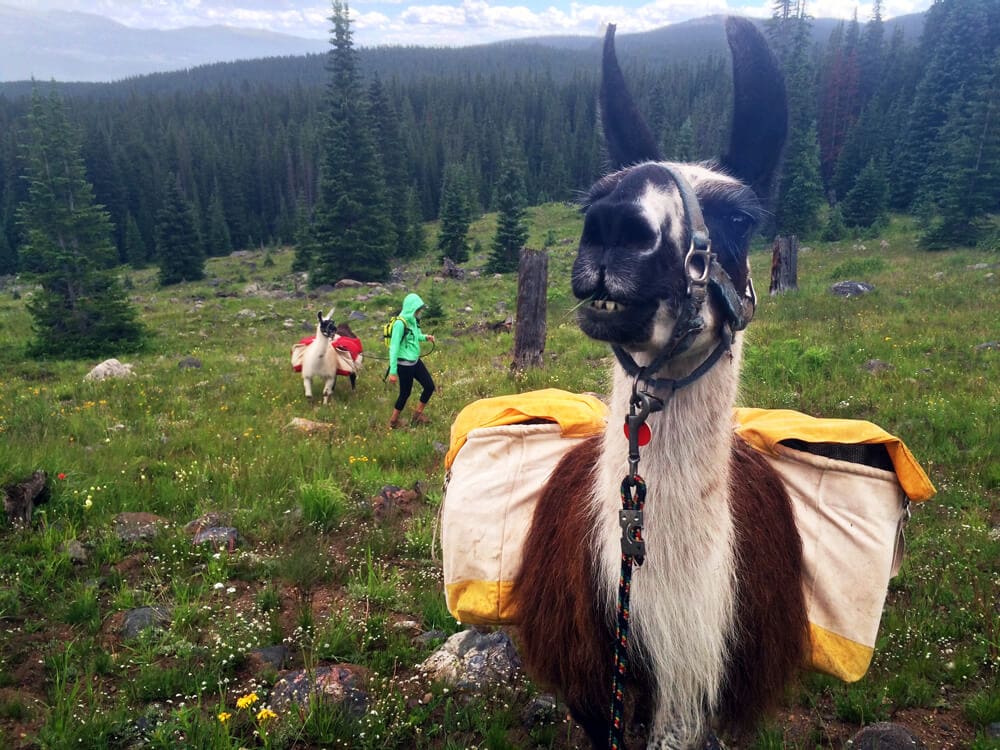“This is Jack,” said my trek leader, introducing me to my escort at the Tennessee Pass Trailhead of the Continental Divide Trail. “He’s an awesome llama, but he can be a little stubborn.”
Jack was one of four llamas that accompanied me and an intrepid group, led by Paragon Guides’ Will Elliott and Nick Vincent, on a hike through the White River National Forest near Vail, Colorado. How Jack’s temperament would influence the experience was yet to be seen as our group meticulously distributed the weight of our cargo over the woolen quartet. In the meantime, I was just happy he wasn’t spitting at me.
Llamas are typically associated with their native mountain range, the Andes of South America, but theses cousins of camels are raised in other areas of the world as well. Born at the Buckhorn Llama Co. in Masonville, Colorado, Jack — along with his counterparts Bailey, Durango and Oreo — was brought up to realize his potential as a pack animal, naturally adapted for high altitudes with minimal environmental impact.
Llamas aren’t strong enough to carry a load until they are at least 7 years old, but when ready, they can pack as much as 30% of their body weight in cargo — in our case, personal effects and provisions, including steaks, cheeses and above all, our all-important bottles of post-hike wine.
Our ultimate destination was the summit of Homestake Peak, one of the Sawatch mountain range’s notables at 13,209 feet. Jack and company would take us to our base shelter at 11,300 feet, a 10th Mountain Division Hut. Built in 1989 in honor of the U.S. Army’s specialized mountain infantry, the structure is no barracks. The cozy cabin comes complete with an iron stove–equipped kitchen, two private bedrooms and enough space to accommodate 16 people. Normally hikers can reserve a spot there, but Paragon Guides booked out the entire house so we could spread out and enjoy some Rocky Mountain hospitality. We just had to get there.
“C’mon, Jack!” I said to my woolly escort, leading him along the trail with a leash like a large, long-necked dog. More accurately, it was him leading me — he’d done this before — as we kept pace with the rest of the group. On occasion, he’d duck down to nibble on some vegetation, and the momentary pause provided an opportunity to partake in what became a recurring phenomenon of the trek: the llama selfie.
This was difficult, however, as Jack proved camera-shy. I tried petting his head and neck, the way I would a dog. He was less than cooperative, always snapping his head back or looking away. Meanwhile, the others were already hashtagging #llamaselfie.
We continued along the gradually ascending trail, engulfed by the canopy of conifers. I might have relished in the clean, mountain air and taken in the bubbly murmurs of nearby creeks, but my bonding with Mother Nature was interrupted by the literal breathing down my neck. I flinched in dismay at Jack’s snorts, as he often surprised me when scratching his nose on my daypack.
Our odd-couple relationship went on hiatus during our group breaks. At Lily Lake, the llamas stood guard, almost regally, while we stopped to snack on protein bars and trail mix. I don’t know what happened during that moment on the lakeshore — perhaps it was the simple serenity of it all — but afterward, Jack started to lighten up. Perhaps he’d grown too tired to be resistant to selfies. Or perhaps he was actually warming up to me.
A passing rain cloud greeted us after a picnic lunch, and I delighted in the peaceful sprinkle. I don’t know if it was my rain-infused reverie or Jack’s propensity to pause for a snack, but somehow we got separated from the group. The pace of the caravan had naturally spread out with each llama’s individual stride, and we were far behind.
The trees and shrubbery of the forest kept the rest of the group out of my peripheral vision, and the trail wasn’t clearly defined. We were lost.
“Hellloooo?!” I called out.
Jack grunted in disappointment.
“We’ll find them, Jack,” I assured my camelid companion. He began humming out a noise, similar to
a whale call, as if trying to hail his wooly brethren.
No response.
Bonded by our state of misplacement, we trekked on, hoping to be found. Eventually we encountered a lone camper pitching a tent.
“Uh, have you seen any llamas?” I asked.
She smiled. “Yeah,” she answered, pointing. “They went that way.”

We finally caught a glimpse of the group in an open meadow of wildflowers. By the time we caught up with them, our destination was in sight. I was relieved when at last we arrived at the cabin, not only because the sun had come out or because Nick and Will were already baking brie to go with the charcuterie and wine. I was happy to get Jack offloaded and properly fed. I led him to a stream for a drink. Nearby was a patch of long grass.
“Let’s get you some of that good stuff,” I told him, petting him on the neck. This time, he didn’t flinch.
The next morning, we bipeds donned our daypacks and headed up to the summit of Homestake Peak and back down before being reunited with our llama counterparts. I was no longer a stranger to Jack, but an old acquaintance, and there was much more cooperation between the two of us on our descent down the mountain.
“It’s a lot easier than walking a dog,” Will said to me, seeing that I’d finally gotten the hang of it.
Now I like dogs as much as the next guy, but take it from me: If you’re trekking the Colorado Rockies with a formidable amount of provisions, you’re definitely going to want to bring a llama. Out there, whether it’ll pose for a selfie or not, a llama is man’s best friend.





